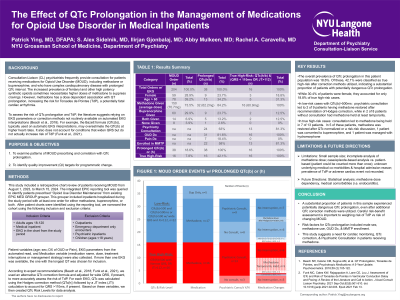Substance Use and Related Disorders
(174) The Effect of QTc Prolongation in the Clinical Management of Opioid Use Disorder in Hospitalized Patients


Patrick Ying, MD, DFAPA
Assistant Professor of Psychiatry
NYU Grossman School of Medicine
New York, New York- RC
Rachel Caravella, MD (she/her/hers)
Director, CL Psychiatry Service
NYU Langone Health
BRIARCLIFF MANOR, New York - SS
Simon A. Sidelnik, MD
Director Addiction Consultation-Liaison Psychiatry
NYU Grossman School of Medicine
New York, New York - IG
Ilirjan Gjonbalaj, MD
Consultation-Liason Psychiatrist
NYU Langone Medical Center
New York, New York - AM
Abby Mulkeen, MD
Attending Psychiatrist, Consultation-Liaison Service
NYU Langone Health
New York, New York
Presenting Author(s)
Co-Author(s)
The Effect of QTc Prolongation in the Clinical Management of Opioid Use Disorder in Hospitalized Patients
Background/Significance
Consultation-Liaison (CL) psychiatrists frequently provide consultation for patients with opioid use disorder (OUD) who have complex cardiopulmonary disease, including prolonged QTc interval and risk for fatal ventricular arrhythmias, including torsades de Pointes (TdP). The increased prevalence of fentanyl and other high potency synthetic opioid use poses a challenge in these situations. Higher doses of methadone are required to suppress cravings in patients using fentanyl and other high potency synthetic opioids; however, methadone has a dose dependent association with QT prolongation and increased risk of TdP, a potentially fatal cardiac arrhythmia.
In order to assess the risk of certain psychotropic medications, the literature suggests relying on EKG parameters not routinely available on automated EKG interpretations. (Beach et al, 2018) For example, the Bazett formula can frequently overestimate the QTc interval at higher heart rates, while patients with conditions causing ventricular conduction delay leading to a widened QRS interval can also lead to a longer QTc interval without indicating increased risk of torsades de pointes. (Funk et al, 2021).
The Consultation-Liaison service at NYU Langone Health has developed tools to help more accurately calculate the QTc interval using the Hodges correction formula and as well as account for widened QRS intervals. This project seeks to identify how QTc prolongation has affected the management of OUD in hospitalized patients, and in particular, the frequency of these tools providing reassuring results after properly correcting for heart rate and widened QRS interval.
Methods
Inpatient admissions to NYU Langone Health over one year were reviewed for orders for medications for OUD (MOUD)– buprenorphine and methadone, revealing 260 charts. These charts will be reviewed for QTc interval, whether MOUD was modified a result of prolonged QTc, dose of methadone or buprenorphine given, and whether Hodges Correction and/or adjustment for wide QRS was done in the setting of ventricular pacing or bundle branch block.
Results
We will report the number of patients receiving methadone and/or buprenorphine, including dosage and the percentage of patients with QTc prolongation via the Bazett correction, and then the percentage of patients with continued prolonged QTc or elevated risk of torsades de Pointes after correction for heart rate using the Hodges correction and correction of widened QRS interval.
Discussion
These results will provide data about the frequency of prolonged or apparently prolonged QTc interval in the settings of treatment of opioid use disorder.over a one year period at a major academic medical center.
References
Beach SR, Celano CM, Sugrue AM, et al. QT Prolongation, Torsades de Pointes, and Psychotropic Medications: A 5-Year Update. Psychosomatics. 2018;59 (2):105-122.
Funk MC, Beach SR, Bostwick JR, et al. QTc Prolongation and Psychotropic Medications. Am J Psychiatry. 2020;177(3):273-274.
Buresh M, Nahvi S, Steiger S, Weinstein ZM. Adapting methadone inductions to the fentanyl era. J Subst Abuse Treat. 2022 Oct;141:108832.
Presentation Eligibility: Not previously published or presented
Diversity, Equity, and Inclusion: This project addresses the treatment of opioid withdrawal in patients requiring inpatient medical treatment. Ultimately this seeks to help medically ill patient with comorbid opioid dependence get effective treatment that will facilitate potentially life saving medical care. Research has suggested that there is a rise in urban addiction and overdose is that likely the combined result of easy accessibility to fentanyl-contaminated heroin and worsening impacts of social determinants of health (SDoH), and that the opioid crisis disproportionately affects Black Americans.

